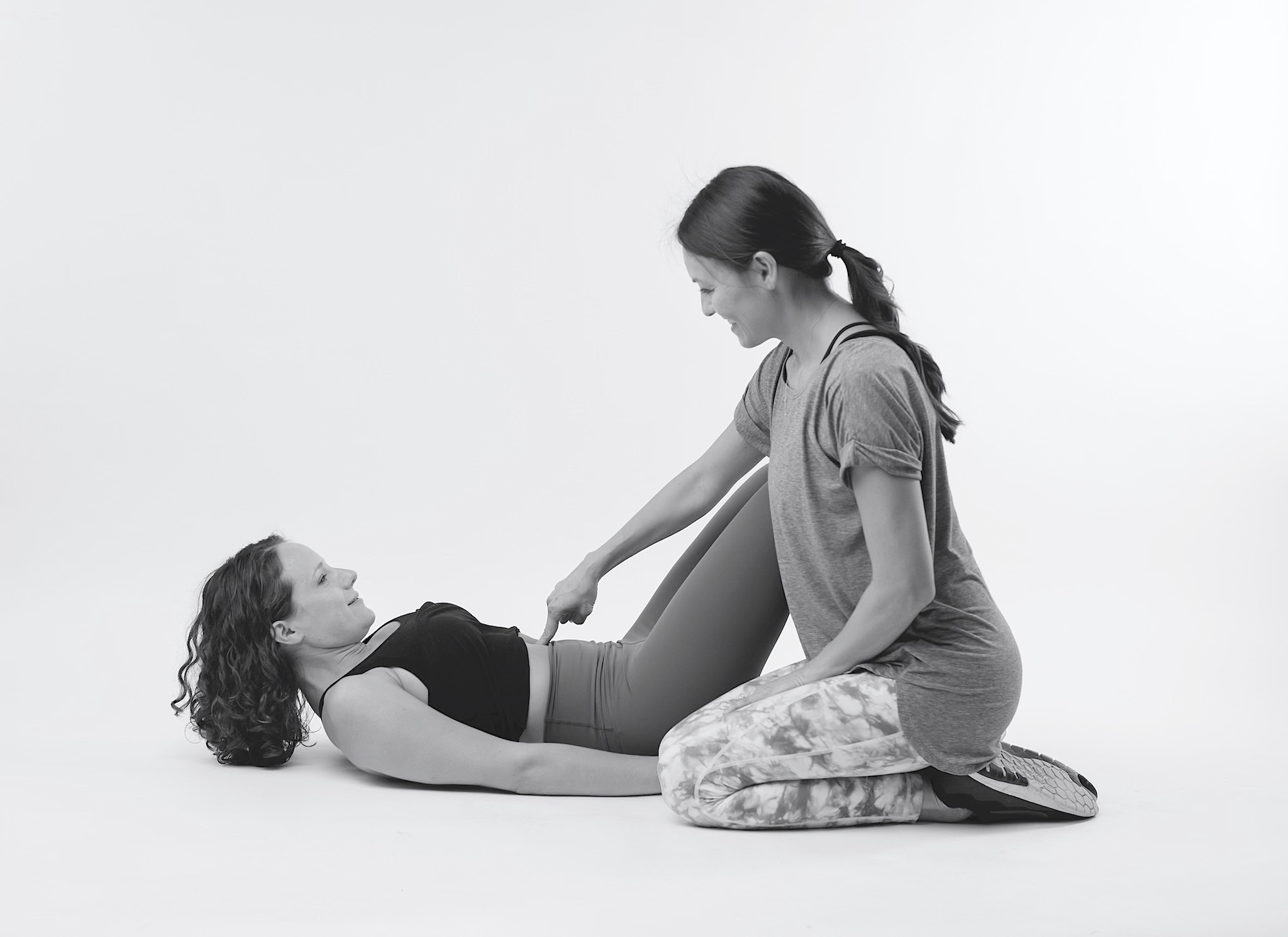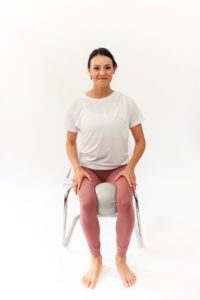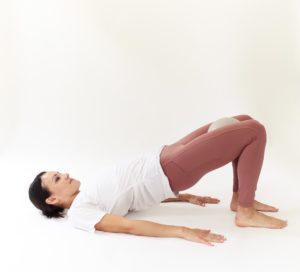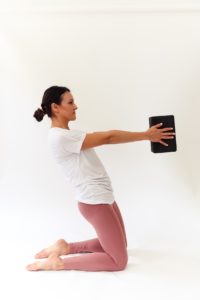Recovering after your C-Section and wondering when and how you can get started on pelvic floor and core workouts? We know you may be itching to regain core strength and function, but returning to exercise should be slow and gradual.
Your Postpartum Pelvic Floor and Core
Your core muscles undergo significant changes during pregnancy, as abdominal and pelvic floor muscles lengthen to accommodate your growing baby.
And during a C-Section, an incision is made through several layers of skin and fascia in the abdominal wall. Good news, though: abdominal muscles are not typically “cut” during a c-section. They are gently separated in the midline to access the uterus.
So with a gradual return to postpartum exercise and some focused core work, you can absolutely regain core strength and function. Read on to learn how to safely regain coordination after a c-section.
Heal your pelvic floor and core after a C-Section
The First Few Days
The first step in c-section recovery is to allowing time for your body to heal. The first few weeks after a cesarean birth should be focused on rest, healing, hydration.
Within the first day after surgery, we encourage you start getting out of bed to walk every day. This helps encourage upright standing and promotes healing and blood flow to your recovering core and pelvic floor.
Tip: When getting out of bed, roll over so you are lying on your side. Use your arms to help you push up to protect your abdominals. Reverse this movement to get back in bed.
You can continue to go on shorts walks, gradually increase the length of walks as you feel able. Scale back if pain or bleeding increase.
All cleared?
You may have heard that women are cleared to exercise at their six-week postpartum checkup, this isn’t necessarily true.
If you do receive the “all clear” it doesn’t mean you are fully healed… It means that there is no sign of a condition or issue requiring medical intervention by the physician. It does *not* mean that your tissues are done healing or that they are ready for high impact.
If you have urinary leakage, pain, pelvic pressure or heaviness, or abdominal doming or coning, consult a pelvic floor physical therapist.
Pelvic floor therapists can evaluate your pelvic floor and abdominal wall. They can also assist with any pain, prolapse, or leakage. Furthermore, they can provide you with a personalized plan for resuming exercise.
Return gradually to your pelvic floor and core workouts
It is usually safe to start exercising after six to eight weeks after giving birth. Low intensity activities, such as walking and gentle core and pelvic floor strengthening exercises, are recommended.
Focus on rebuilding your core and pelvic floor muscles during the first 12 weeks postpartum. After that, you can return to more strenuous activities, such as running, weightlifting, or High Intensity Interval Training (HIIT).
Higher intensity activities put a greater demand on the muscles of the pelvic floor and abdomen. These are the best exercises to avoid until at least three to six months postpartum.
Safe Workouts After C-Section
The initial and most important piece of exercise after c-section is to start retraining and restrengthening your core. These activities bring good blood flow to the pelvic region and start working those muscles again without adding unwanted strain.
We often think of the “core” as just your abdominal wall. Your core is composed of several muscles. These include your abdominals, pelvic floor, and low back muscles. We also consider your diaphragm as part of your core, providing support from above.
Start with the following pelvic floor and core exercises to help rebuild your foundation and strength and get you back to feeling strong.
Diaphragmatic breathing
Diaphragmatic breathing is the first exercise to start reconnecting with your core after c-section. What does breathing have to do with your core? Everything!
Holding your breath may keep your abdominal muscles tense and prevent an optimal pelvic floor muscle contraction. Also, diaphragmatic breathing helps expand tight tissues around your c-section scar to minimize scar restriction.
This can be performed in any position, including lying down, sitting (while feeding your baby is a convenient time!) or standing. We encourage you to start by lying down.
- Lie flat on your back with knees bent and feet resting on the floor.
- Rest one hand on each side of your ribcage.
- As you inhale, allow the ribcage to inflate in all directions. Think of your ribs opening up like an umbrella on all sides. Allow the belly to inflate and let go of any tension in the neck and shoulders.
- Exhale naturally as you let your breath go.
- Gradually deepen the breath without straining and work up to 4-second inhales and 4-second exhales.
Transverse abdominis contraction
The transverse abdominals are the deepest layer of your abdominal wall. A great way to engage these muscles is to think about doing a pelvic floor muscle contraction, also known as a Kegel, as these muscles work with the pelvic floor.
You may think, “I had a c-section, do I really need to do Kegels to strengthen my pelvic floor?” Maybe! Your pelvic floor muscles lengthen during pregnancy, and many may do some pushing during labor if a cesarean isn’t planned.
- Lie flat on your back with knees bent and feet resting on the floor.
- Perform a diaphragmatic breath inhalation to prepare.
- Exhale and perform a Kegel and transverse abdominal contraction as you imagine drawing your pelvic floor and lower abdominals in.
A Kegel is a pelvic floor contraction and lift. Imagine sucking up a smoothie with your vagina, or stopping the flow of urine and holding back gas.
To contract the transverse abdominis muscle, imagine gently drawing your hip bones and the area surrounding your c-section scar together. This is very subtle but engages your deep core and pelvic floor muscles.
- Inhale and repeat.
Ball squeeze
It’s important to learn to use your pelvic floor muscles with movement. Contracting your inner thigh muscle can help activate your pelvic floor and transverse abdominals.
Ball squeeze exercise is a simple and effective way to start activating your core. It can be performed lying down on your back or in sitting position with your feet on the floor.
- Lie flat on your back with knees bent and feet resting on the floor. Place a yoga block, soccer ball or soft pillow between your knees.
- Inhale to prepare.
- Exhale and squeeze the block between your knees. Gently draw in your lower abdomen and pelvic floor, engaging your core.
- Inhale to repeat.
Bridges
The next progression of core activation is learning to turn on the glute muscles with a pelvic floor contraction.
During pregnancy your gluteal muscles can flatten and turn-off due to postural changes. Activating these muscles and contracting with your deep abdominal and pelvic floor strengthens your core. It also helps with hip and pelvic stability.
- Lie flat on your back with knees bent and feet resting on the floor. You will want to bring your feet closer to your bottom before starting.
- Inhale to prepare.
- Exhale as you drive through your heels to raise your hips off the floor.
- In the top position, squeeze your buttocks and gently draw in your lower abdomen and pelvic floor.
- Inhale back down and repeat.
Kneeling hip thrust
Learning to activate and strengthen muscles in different positions against gravity is essential.
We use our core muscles to get out of a chair, get off the floor, and bend over to lift baby. You want to train your core muscles in the positions you will use them throughout the day.
This exercise is a progression of the bridge exercise above and a great way to challenge your core against gravity.
- Start in a tall kneeling position, with your upper body upright as you sit back on your lower legs.
- Inhale to prepare.
- Exhale and rise up onto your knees. In the top position, squeeze your buttocks and gently draw in your lower abdomen and pelvic floor.
- Inhale back down and repeat.
Start out by doing one set of 10 repetitions of each exercise each day. Progress to perform two to three sets of 10 repetitions each per day. Increase the hold time of each exercise to five seconds.
Discontinue if pain or discomfort occur and check in with a pelvic floor physical therapist. You can also add in yoga, upper and lower body strengthening, walking, cycling or the elliptical starting at eight weeks postpartum.
When to back off pelvic floor and core workouts
If you notice any of the symptoms below, seek the help of a pelvic floor physical therapist. We also recommend not exercising without the approval of your doctor.
- Urinary incontinence
- Leaking poop
- Difficulty pooping
- Painful intercourse
- Pelvic and/or low back pain
- Heaviness, pressure, or bulging in the low pelvis (may point to pelvic organ prolapse)
- Abdominal bulging
- Cesarean scar pain, numbness or sensitivity
______________________________________________________________________________________________________
Are you currently pregnant or planning to conceive? If so, make sure to download my FREE resource — How to Prepare Your Pelvic Floor & Core for Childbirth + 8 Must-Dos for C-Section and Vaginal Deliveries.
______________________________________________________________________________________________________
Some links may be affiliate links. The products we recommend are products we use or recommend to clients.










